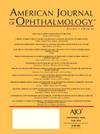中度黄斑变性钙化Drusen的黄斑负担与大脉络膜超透射性缺陷的发生。
IF 4.1
1区 医学
Q1 OPHTHALMOLOGY
引用次数: 0
摘要
目的:本研究采用面扫源光学相干断层扫描(SS-OCT)成像技术,对存在和不存在钙化结节(CaD)的中度年龄相关性黄斑变性(iAMD)患者进行随访,以确定钙化结节的存在和大小是否会增加形成大脉络膜超透射缺陷(hyperTDs)的风险。设计前瞻性队列研究的事后亚组分析。方法将患有iAMD的患者纳入前瞻性SS-OCT研究,回顾性分析大的高tds的发病情况。在基线和随访时使用6×6 mm SS-OCT血管造影(SS-OCTA)扫描进行成像。大hypertd被定义为位于Bruch膜(BM)下64-400µm的表面视网膜下色素上皮(subRPE)板上最大线性尺寸(GLD)≥250µm的明亮病变。CaD被确定为具有非均匀内反射率的患者,在相同的subpe板上投射脉络膜低透射缺陷(hypods)。通过b片分析,将CaD与高反射病灶(hyperreflective focal, HRF)区分开来。两名独立评分员使用半自动算法来完善CaD轮廓并达成共识,分歧由一名高级评分员裁决。在5 mm的中心圆内测量CaD面积、HRF面积和结节体积。结果121例患者171只眼的中位随访时间为59.1个月(95% CI: 52.0 ~ 67.8个月),82只眼在随访期间出现至少一次大的hyperTD。发生hypertd的眼睛的平均基线CaD面积测量为0.037 mm²[范围:0-0.567 mm²],而未发生hypertd的眼睛的平均基线CaD面积测量为0.008 mm²[范围:0-0.360 mm²](P = 0.01)。当单独考虑时,Drusen容积、HRF面积和CaD面积是高td发病的预测因子,但当使用多变量Cox回归分析时,只有HRF面积(P < 0.001)和CaD面积(P = 0.008)仍然是高td发病的显著预测因子。无论面积如何,任何CaD的存在都增加了超td形成的风险(P < 0.001)。结论在多变量Cox回归分析中,iAMD患者眼内CaD和HRF面积测量值是高td发病的重要预测因子,任何CaD的存在都增加了高td形成的风险。本文章由计算机程序翻译,如有差异,请以英文原文为准。
The Macular Burden of Calcified Drusen and the Onset of Large Choroidal Hypertransmission Defects in Intermediate AMD.
PURPOSE
This study used en face swept-source optical coherence tomography (SS-OCT) imaging to follow eyes with intermediate age-related macular degeneration (iAMD) in the presence and absence of calcified drusen (CaD) to determine if the presence and size of CaD increased the risk of forming large choroidal hypertransmission defects (hyperTDs).
DESIGN
Post hoc subgroup analysis of a prospective cohort study.
METHODS
Eyes with iAMD were enrolled in a prospective SS-OCT study, and the onset of large hyperTDs was retrospectively analyzed. Imaging was performed using 6×6 mm SS-OCT angiography (SS-OCTA) scans at baseline and follow-up. Large hyperTDs were defined as bright lesions ≥250 µm in greatest linear dimension (GLD) on en face sub-retinal pigment epithelium (subRPE) slabs positioned 64-400 µm beneath Bruch's membrane (BM). CaD were identified as drusen with heterogeneous internal reflectivity projecting choroidal hypotransmission defects (hypoTDs) on the same subRPE slabs. CaD were distinguished from hyperreflective foci (HRF) by analyzing corresponding B-scans. Two independent graders used a semiautomated algorithm to refine CaD outlines and reach consensus, with disagreements adjudicated by a senior grader. CaD area, HRF area, and drusen volume were measured within 5-mm fovea-centered circles.
RESULTS
Median follow-up time for the 171 eyes from 121 patients followed in this study was 59.1 months (95% CI: 52.0-67.8 months), and 82 eyes developed at least one large hyperTD during follow-up. The mean baseline CaD area measurement was 0.037 mm² [range: 0-0.567 mm²] in eyes that developed hyperTDs, while in eyes that did not, it was 0.008 mm² [range: 0-0.360 mm²] (P = 0.01). Drusen volume, HRF area, and CaD area were predictors for hyperTD onset when considered alone, but only HRF area (P < 0.001) and CaD area (P =.008) remained significant predictors for hyperTD onset when using a multivariable Cox regression analysis. Regardless of area, the presence of any CaD increased the risk of hyperTD formation (P < 0.001).
CONCLUSIONS
In a multivariable Cox regression analysis, the area measurements of CaD and HRF in eyes with iAMD were significant predictors of hyperTD onset, and the presence of any CaD increased the risk of hyperTD formation.
求助全文
通过发布文献求助,成功后即可免费获取论文全文。
去求助
来源期刊
CiteScore
9.20
自引率
7.10%
发文量
406
审稿时长
36 days
期刊介绍:
The American Journal of Ophthalmology is a peer-reviewed, scientific publication that welcomes the submission of original, previously unpublished manuscripts directed to ophthalmologists and visual science specialists describing clinical investigations, clinical observations, and clinically relevant laboratory investigations. Published monthly since 1884, the full text of the American Journal of Ophthalmology and supplementary material are also presented online at www.AJO.com and on ScienceDirect.
The American Journal of Ophthalmology publishes Full-Length Articles, Perspectives, Editorials, Correspondences, Books Reports and Announcements. Brief Reports and Case Reports are no longer published. We recommend submitting Brief Reports and Case Reports to our companion publication, the American Journal of Ophthalmology Case Reports.
Manuscripts are accepted with the understanding that they have not been and will not be published elsewhere substantially in any format, and that there are no ethical problems with the content or data collection. Authors may be requested to produce the data upon which the manuscript is based and to answer expeditiously any questions about the manuscript or its authors.

 求助内容:
求助内容: 应助结果提醒方式:
应助结果提醒方式:


